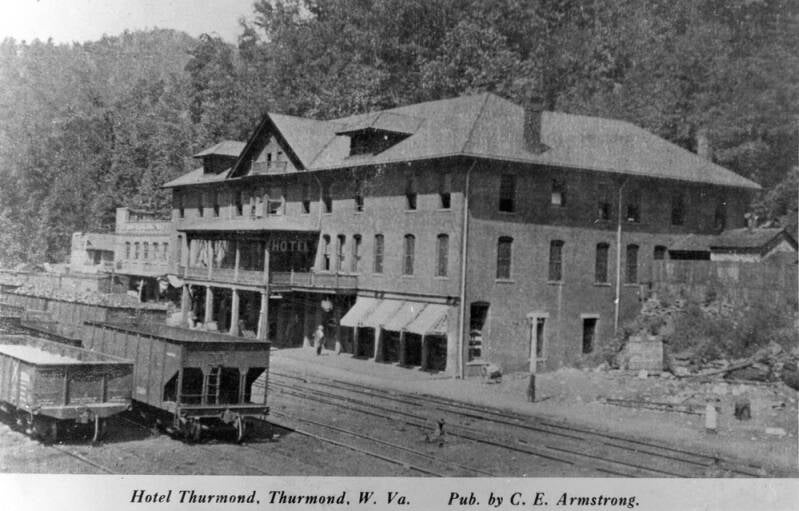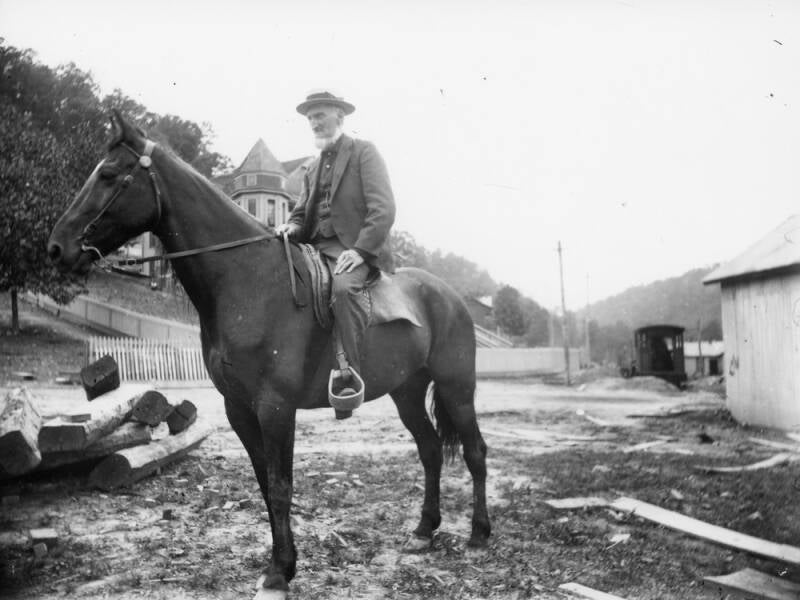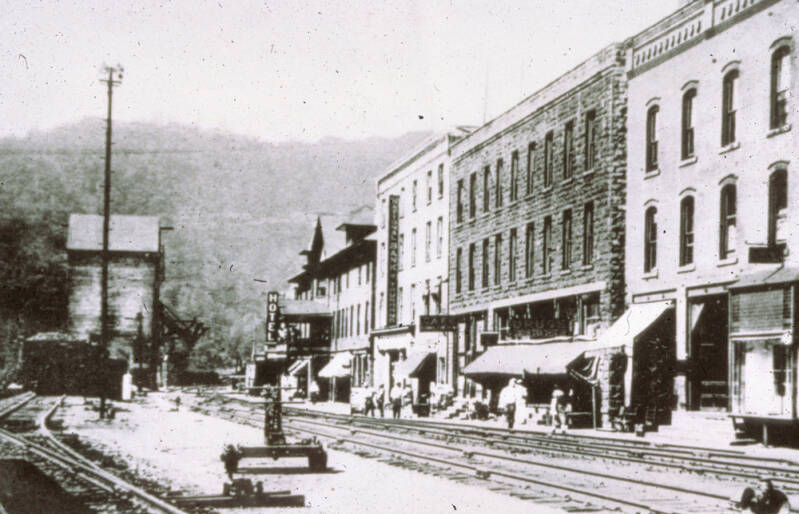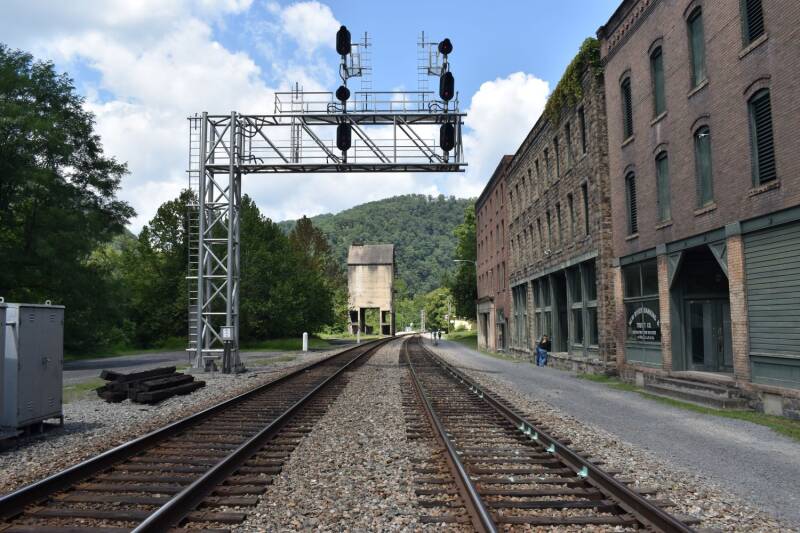Thurmond
The town of Thurmond, such as Hamlet, Glade and a few others, wasnt built for the coal industry. It simply was not a coal town. It was built to serve the railroad that drove the life force in the New River Gorge.
The town of Thurmond was different in many ways, but none so more different than the way the land was purchased, or rather granted. Founded by Capt. William Dabney Thurmond, a lifelong resident of Fayette County. At the age of 22, he had came to this part of Fayette County, then the commonwealth of Virginia. (West Virginia would not become its own separate state until June, 20, 1863). His family settled on Arbuckle Creek, across from today's town of Thurmond, in the little community of Minden. He was a devout, religious man with strong ties to his southern heritage and at the age of 44, joined the Confederacy to defend his southern ways.
Because of his life in the New River Gorge, Thurmond was beneficial in the battles fought along the New. He knew every creek, every loyal family, every plant and animal his men could eat to survive. Something most northern soldiers could not do. He was soon awarded the rank of Captain over a guerrilla band of fighters soon to be called, Thurmond's Rangers. Even long after the end of the Civil War, he was always known and respected as Captain Thurmond.
Whether by accident, divine providence or sheer accidental luck, Thurmond was hired by land owner, John Bowyer, in 1873 to survey his tract of land on the north side of the New River. As the news of the C&O's continued development into the region, landowners were eager to find out exactly how much coal and timber they had on their land and its potential value. Little is known to the reasoning behind Thurmond's little deal with Bowyer but the fact that trading things was far more important and valuable in the New River Gorge than a pocket full of cash, Capt. Thurmond offered to survey John Bowyer's land not for pay, but for trade. He wanted a 73 acre track of land, that, well, John Bowyer couldnt understand why he wanted such a worthless tract. History recalls those 73 acres as being a little more than a shelf along the Gorge walls. So the deal seemed fair to Bowyers, and in April of 1873, Capt. Thurmond gained title to the land he desired. And in that same year, the C&O met its deadline and merged east and west lines at Hawks Nest.
Again, little is known of the reasoning behind his desire for these 73 acres, but it did prove to be very beneficial to Thurmond. Some have theorized that maybe Thurmond knew what the future could hold. Not a premonition, but perhaps it was the pure and simple fact of his little slice of the New River Gorge was sitting at the confluence of the C&O's mainline on the north side and two beneficial creeks on the south side. Perhaps he figured that coal investors would soon be buying up rights to coal seems up and down both the Loup Creek, (today called Dunloup Creek), towards Glen Jean and Arbuckle Creek up towards Minden.
Maybe it was just common sense that he had figured out that the railroad would have to merge there at Thurmond to service the other coal companies that were sure to spring up seemingly over night.
To be noted, the New River Gorge does not have a wealth of flatland. Its little more than a "bench" of flat land on either side of the river, barely enough room in most of the areas to even lay a set of train tracks. Houses were built on the hillside, usually among the massive rocks and boulders that dot the mountainous landscape, and Thurmond was no exception. Again, Thurmond, unlike the other communities along the Gorge, was not built to service coal mines in the area, it was intended to service the railroad.
Unlike others who settled in the area, such as John Nuttall, Joseph Beury and others, Capt. Thurmond didnt have the financial wealth to start his little slice of Gorge heaven like they did. Even as long as decade after the railroad was completed, Capt. Thurmond and his family carved out a meager living in the New River area. He had established a water crossing ferry up river from Arbuckle Creek and carried people and goods from one side of the river over to the other. For little as 20 cents a load, he ferried wagons of goods across the New River to better serve the influx of miners and the booming small coal towns that continued to spring forth.
Thurmond would not begin building his little town for quite some time. It was'nt incorporated until 1903. Thirty years after Capt. Thurmond gained ownership of the land. At its height, the banks in Thurmond were deemed to be some of the richest banks in the state. Some estimate that nearly 15 passenger trains came through Thurmond a day and estimated that the town serviced over 75,000 visitors a year. But, as with most communities that depend on coal, as the markets for the mineral declined or the mines worked out and shut down, so begins to demise of the towns in the area.
Capt. Thurmond's religious beliefs were strong being a devout Baptist. Strong enough in fact that he had specific laws laid out in Thurmond regarding conduct in his little town. Unlike most rough and rowdy towns, Thurmond banned drinking, bars and brothels. Coal miners from neighboring coal towns would catch a train to Thurmond, the closest thing they had to a "big town", with new pay in their pockets and a hole in their pants eager to let that cash slip away.
But by the mid 1890's, Thurmond was growing in leaps and bounds. Three banks, grocery and dry goods store, jewelry store, business offices and Capt. Thurmond's own Thurmond Hotel was built in 1891 and boasted of 25 rooms. It was later replaced by the Layfette Hotel, (pronounced lay-flat by locals). The Armour Meat Packing facility was built next to the Layfette Hotel, but sadly, both burned to the ground in the early 1960's. Business offices sprang up in Thurmond along with continued rail growth and soon Thurmond was the center hub of rail activity for the C&O in the New River . It had once been said that at its height, Thurmond had shipped more rail traffic than Cincinnatti, Ohio. Thurmond's desire for this specific little tract of land had finally paid off.
But Capt. Thurmond's devout baptist beliefs and his unwillingness to allow drinking, gambling and prostitution into Thurmond eventually lead to others taking advantage across the river on the Loop Creek side. Brothels, bars, gambling houses and the likes were soon springing up across the river but a little more on that will be discussed on the Glen Jean page. Perhaps Glen Jean was not exactly in the New River Gorge but it was super beneficial to the growth and expanse of the New River coal fields.

Thurmond Hotel, Armour Meat facility down stream source NPS
The C&O took advantage of the town and soon sidings were added to temporarily park rail cars waiting to be shipped. A 50 foot turntable was constructed to switch directions with the locomotives, but soon was rebuilt with a new 100 foot turntable. A machine house was built enabling the railroad to repair and service steam locomotives and freight cars that traveled the New River area.
A water tank capable of holding 100,000 gallons of water, served most of the railroad needs until a newer, bigger one was built able to hold over 210,000 gallons. Thurmond was indeed a rail town and it served the line well. Today, only the concrete pads that the water tanks stood on still exist. The tanks were removed by the CSX Railroad, formerly the C&O, in 1998, due to deterioration.
The initial name for the little town was not actually Thurmond. In 1888 the Thurmond family had applied for a post office. Capt. Thurmond wanted the name of his little slice of the gorge to be called, "Arbuckle", possibly because of his ties with neighboring Arbuckle Creek across the river that lead up to his home in Minden. But the application was denied simply due to the name of Arbuckle, and the Thurmond family reapplied with a new name, "Thurmond, West Virginia". The application was granted and thus Thurmond became a true little booming town nestled in the direct center of the New River Gorge.
Main street Thurmond at the turn of the century source C&O Historical Main street Thurmond today source author
Thurmond's main street, if one could call it that, was not typical street either. Barely room between the only sidewalk in town and the busy main line of the C&O railroad. Complicated it would be for two horse drawn wagons to pass one another and keep off the track.
Today, one can imagine, as you walk the gravel road in front of the few remaining buildings, days long since passed. The sights and smells of busy sidewalk, bustling businessmen rushing to and fro. The smell of coal burning in the steam engines sitting on side tracks awaiting their turn to travel off to heaven knows where. Sounds of the steam whistles blowing none stop at the only railroad crossing in town. Once, such a long time ago, Thurmond had a population of over 500, not including visitors to the area or those soon to step out in search of a job and a place to live in nearby coal camps. Today, as of the 2023 census, Thurmond's population is now, sadly, only 3.
Hard to imagine today, what it was really like over a century ago. But, like with most of southern West Virginia, dependent upon the growth of the coal industry, as the demand for coal and the available resources dwindled, so did the need for the town. Today, with modern mining technology, a coal company can mine deeper, farther and more of the seam that they are mining than they could in the late 1880's to early 1900's. Mines did not last to long because it was no longer financially efficient to continue to mine.

































